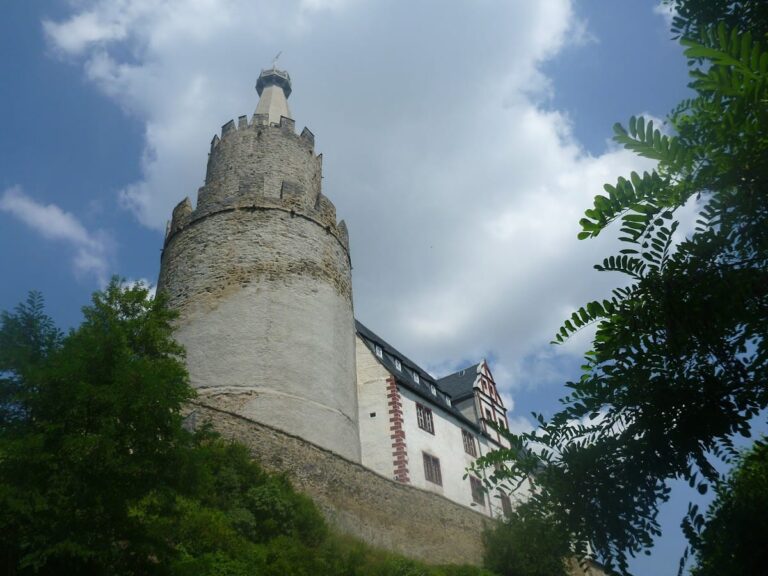Schloss Fröhliche Wiederkunft: A Historic Renaissance Castle in Wolfersdorf, Germany
Visitor Information
Google Rating: 3.7
Popularity: Low
Google Maps: View on Google Maps
Official Website: www.schloss-wolfersdorf.de
Country: Germany
Civilization: Unclassified
Remains: Military
History
Schloss Fröhliche Wiederkunft is situated in the village of Wolfersdorf within the municipality of Trockenborn-Wolfersdorf, Germany. It was created by the Saxon Renaissance civilization during the mid-16th century.
The castle’s origins date back to the period between 1548 and 1550, when Elector Johann Friedrich I of Saxony commissioned architect Nikolaus Gromann to construct a new hunting lodge. This building replaced an earlier princely lodge in Trockenborn that was destroyed in 1547 during the Schmalkaldic War. The new lodge was later named “Fröhliche Wiederkunft,” which translates to “Happy Return,” in honor of Johann Friedrich’s release from captivity in 1552 and his subsequent reunion with family at the estate.
Throughout the 16th and 17th centuries, Schloss Fröhliche Wiederkunft remained an active hunting retreat for Johann Friedrich’s successors in Saxony. However, by the mid-17th century, around 1650, the primary hunting activities shifted to Schloss Hummelshain, resulting in the castle’s gradual decline in status and its reassignment as premises for the princely hunting administration rather than a royal residence.
A wave of revitalization arrived in the 19th century under Duke Joseph of Saxe-Altenburg, who abdicated in 1848 and later oversaw a major restoration and expansion project from 1858 to 1865. This renovation adapted the castle to the neo-Gothic style, a popular architectural revival at the time, and included the addition of four large painted panels that portrayed episodes from Johann Friedrich I’s life, enriching the interior with historical imagery.
In the early 20th century, following his own abdication in 1918, Duke Ernst II made the castle his home beginning in 1922. He enhanced the site with the installation of a modern observatory, a project carried out with the assistance of Kurd Kisshauer, marking a shift from the building’s hunting legacy towards scientific pursuits.
Following World War II, the castle was expropriated under the Soviet land reform of 1945–46, although Duke Ernst II maintained residence rights until his death in 1955, living there as a citizen of the German Democratic Republic. After this period, the castle became public property and underwent functional changes, including conversion into a youth work home until 1990. During this time, the condition of the building suffered significantly.
In the years that followed, efforts to protect and restore Schloss Fröhliche Wiederkunft were undertaken. In 1997, the surrounding pond was cleaned, with unexploded munitions recovered from its depths. Subsequently, in 2007, ownership passed to a private individual from Jena who began comprehensive restoration with support from both the Free State of Thuringia and the German Foundation for Monument Protection. By 2013, these efforts facilitated the reopening of parts of the castle for public engagement.
Remains
Schloss Fröhliche Wiederkunft is prominently situated on an island within a small lake at the heart of Wolfersdorf, standing approximately 271 meters above sea level. Its main structure is L-shaped and consists of two stories made with half-timbered construction resting on a stone foundation. This style combines a sturdy stone ground floor with lighter timber framing above, typical of the period’s regional architecture.
Originally, the castle included eight heated parlors and eleven chambers, indicating a design intended for comfort and extended use during hunting seasons. Access between floors is provided by a wooden stair tower, which remains a key feature of the building’s original layout. The core of the castle has been largely preserved in its initial form despite centuries of change.
The surrounding outbuildings that supported the castle’s economic functions underwent significant renewal and alterations during the 19th century when the neo-Gothic expansion took place. This renovation introduced decorative elements and expanded parts of the estate, reflecting 19th-century tastes and restoration trends.
Inside, the interior once housed four large-format painted panels illustrating scenes from the life of Elector Johann Friedrich I. These artworks were installed during the 19th-century restoration under Duke Joseph of Saxe-Altenburg. Although the panels were later removed, they have been preserved and are now part of the collection at the German Historical Museum in Berlin.
The castle’s moat-like pond, integral to its island setting, was subjected to desilting in 1997. This process also revealed unexploded ordnance within the pond’s sediments, which was carefully removed as part of site clearance and preservation efforts.
Prior to restoration efforts that began in 2007, the building suffered from structural damage severe enough to put parts at risk of collapse. Since then, the castle has been stabilized and rehabilitated. Today, the restored lower floor accommodates a café with outdoor seating, indicating an adaptation of the historic space for contemporary use without compromising its essential character. Guided tours make various portions of the castle accessible to visitors, allowing continued appreciation of its architecture and history.










